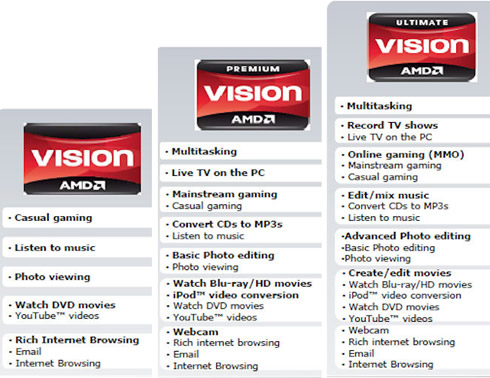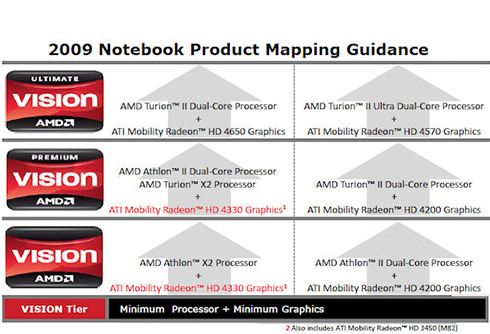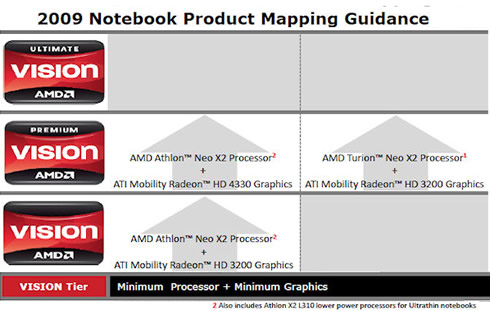
AMD Simplifies PC Buying With VISION Technology
AMD today announced a new way to help consumers select the PC that best meets their needs with the VISION Technology.
Rather than the traditional model, which focuses on the technical specifications of individual hardware components, VISION communicates the value of the whole system and demonstrates the combined processing power of both the CPU and GPU. It emphasizes how an AMD-based PC is optimized for video, digital media and content creation activities.
 "Today's consumer cares about what they can do with their PC, not what?s inside," said Nigel Dessau, CMO of AMD. "They want a rich HD and entertainment experience on their PC, delivered by the combined technology of AMD CPUs and GPUs, without having to understand what gigahertz and gigabytes mean. VISION technology from AMD reflects the maturation of marketing in the PC processing industry and communicates the technology in a more meaningful way."
"Today's consumer cares about what they can do with their PC, not what?s inside," said Nigel Dessau, CMO of AMD. "They want a rich HD and entertainment experience on their PC, delivered by the combined technology of AMD CPUs and GPUs, without having to understand what gigahertz and gigabytes mean. VISION technology from AMD reflects the maturation of marketing in the PC processing industry and communicates the technology in a more meaningful way."
Notebook PCs with VISION Technology from AMD are expected to be widely available on retail shelves and online during the holiday buying season timed to the release of the Windows 7 operating system from Microsoft. Complementing VISION, Windows 7 supports DirectX 10, Direct X10.1, and Direct X11 and a Unified Video Decoder to free up the CPU. This last activity is greatly simplified and much more rapid with the new Drag and Drop feature of Windows 7.
 AMD?s 2009 notebook platforms, also announced today, serve as the first proof points for VISION Technology. Mainstream OEM notebooks offered with VISION have next-generation HD graphics technology for rich, vivid HD and Blu-ray video playback, life-like 3D games, brilliant, clear photos, and multi-tasking power for editing photos, music and videos.
AMD?s 2009 notebook platforms, also announced today, serve as the first proof points for VISION Technology. Mainstream OEM notebooks offered with VISION have next-generation HD graphics technology for rich, vivid HD and Blu-ray video playback, life-like 3D games, brilliant, clear photos, and multi-tasking power for editing photos, music and videos.
For consumers seeking rich PC experiences in a very thin and stylish notebook, ultrathin OEM notebooks with VISION are designed to deliver balanced performance and a superior visual experience at accessible price points. VISION technology contains three levels of increasingly rich PC system capabilities: VISION Basic, VISION Premium, and VISION Ultimate to reflect the different usage patterns of PC consumers: from digital consumption to content creation.

These notebook platforms bring visually-rich experiences to consumers through features such as:
- UP to one billion colors for clear photos and videos,
- DirectX 10.1 for smooth, lifelike games,
- 7.1 audio for pulse-pounding music; and
- Blu-ray support for the latest movies.
For mainstream notebooks, the VISION ULTIMATE platform inlcudes the AMD Turion II + Mobility Radeon HD 4650 or Turion II + Mobility Radeon HD 4570, VISION PREMIUM includes AMD Athlon II/Turion X2 + Mobility Radeon HD 4330 or Turion II + Mobility Radeon HD 4200 and the VISION MAINSTREAM includes the AMD Athlon X2 + Mobility Radeon HD 4330 or Athlon II + Mobility Radeon HD 4200:

AMD has not included the AMD ULTIMATE logo to the ultra-thin notebooks. These AMD VISIO products will be mainly based on the company's 'Tigris' platform. The AMD PREMIUM notebooks will be powered by an AMD Athlon Neo X2 + Mobility Radeon HD 4330 or an Athlon Neo X2 + Mobility Radeon HD 3200. The AMD VISION logo will be found in ultra-thin notebooks with Athlon Neo X2 + Mobility Radeon HD 3200 graphics.

More information about AMD's new 'Tigris' and 'Kongo' platforms for the ultra-thin notebooks is available here and here, respectively.
In the first quarter of 2010, AMD plans to introduce a fourth level, VISION Black, to enable the highest end capabilities sought by enthusiasts, primarily on desktop PCs.
Completing the VISION Technology from AMD announcement, AMD launches the new Fusion Media Explorer software utility and the Fusion Utility for Mobility. Fusion Media Explorer showcases VISION Technology from AMD with:
- A 3D interface for managing media,
- Shortcuts for uploading and sharing photos on Facebook and Flickr,
- An Auto DJ for queuing up music files, and much more.
Fusion Utility for Mobility is a software utility that turns off background processes to enable longer battery life while on the go. Both applications are available for download.
 "Today's consumer cares about what they can do with their PC, not what?s inside," said Nigel Dessau, CMO of AMD. "They want a rich HD and entertainment experience on their PC, delivered by the combined technology of AMD CPUs and GPUs, without having to understand what gigahertz and gigabytes mean. VISION technology from AMD reflects the maturation of marketing in the PC processing industry and communicates the technology in a more meaningful way."
"Today's consumer cares about what they can do with their PC, not what?s inside," said Nigel Dessau, CMO of AMD. "They want a rich HD and entertainment experience on their PC, delivered by the combined technology of AMD CPUs and GPUs, without having to understand what gigahertz and gigabytes mean. VISION technology from AMD reflects the maturation of marketing in the PC processing industry and communicates the technology in a more meaningful way."
Notebook PCs with VISION Technology from AMD are expected to be widely available on retail shelves and online during the holiday buying season timed to the release of the Windows 7 operating system from Microsoft. Complementing VISION, Windows 7 supports DirectX 10, Direct X10.1, and Direct X11 and a Unified Video Decoder to free up the CPU. This last activity is greatly simplified and much more rapid with the new Drag and Drop feature of Windows 7.
 AMD?s 2009 notebook platforms, also announced today, serve as the first proof points for VISION Technology. Mainstream OEM notebooks offered with VISION have next-generation HD graphics technology for rich, vivid HD and Blu-ray video playback, life-like 3D games, brilliant, clear photos, and multi-tasking power for editing photos, music and videos.
AMD?s 2009 notebook platforms, also announced today, serve as the first proof points for VISION Technology. Mainstream OEM notebooks offered with VISION have next-generation HD graphics technology for rich, vivid HD and Blu-ray video playback, life-like 3D games, brilliant, clear photos, and multi-tasking power for editing photos, music and videos.
For consumers seeking rich PC experiences in a very thin and stylish notebook, ultrathin OEM notebooks with VISION are designed to deliver balanced performance and a superior visual experience at accessible price points. VISION technology contains three levels of increasingly rich PC system capabilities: VISION Basic, VISION Premium, and VISION Ultimate to reflect the different usage patterns of PC consumers: from digital consumption to content creation.

These notebook platforms bring visually-rich experiences to consumers through features such as:
- UP to one billion colors for clear photos and videos,
- DirectX 10.1 for smooth, lifelike games,
- 7.1 audio for pulse-pounding music; and
- Blu-ray support for the latest movies.
For mainstream notebooks, the VISION ULTIMATE platform inlcudes the AMD Turion II + Mobility Radeon HD 4650 or Turion II + Mobility Radeon HD 4570, VISION PREMIUM includes AMD Athlon II/Turion X2 + Mobility Radeon HD 4330 or Turion II + Mobility Radeon HD 4200 and the VISION MAINSTREAM includes the AMD Athlon X2 + Mobility Radeon HD 4330 or Athlon II + Mobility Radeon HD 4200:

AMD has not included the AMD ULTIMATE logo to the ultra-thin notebooks. These AMD VISIO products will be mainly based on the company's 'Tigris' platform. The AMD PREMIUM notebooks will be powered by an AMD Athlon Neo X2 + Mobility Radeon HD 4330 or an Athlon Neo X2 + Mobility Radeon HD 3200. The AMD VISION logo will be found in ultra-thin notebooks with Athlon Neo X2 + Mobility Radeon HD 3200 graphics.

More information about AMD's new 'Tigris' and 'Kongo' platforms for the ultra-thin notebooks is available here and here, respectively.
In the first quarter of 2010, AMD plans to introduce a fourth level, VISION Black, to enable the highest end capabilities sought by enthusiasts, primarily on desktop PCs.
Completing the VISION Technology from AMD announcement, AMD launches the new Fusion Media Explorer software utility and the Fusion Utility for Mobility. Fusion Media Explorer showcases VISION Technology from AMD with:
- A 3D interface for managing media,
- Shortcuts for uploading and sharing photos on Facebook and Flickr,
- An Auto DJ for queuing up music files, and much more.
Fusion Utility for Mobility is a software utility that turns off background processes to enable longer battery life while on the go. Both applications are available for download.





















